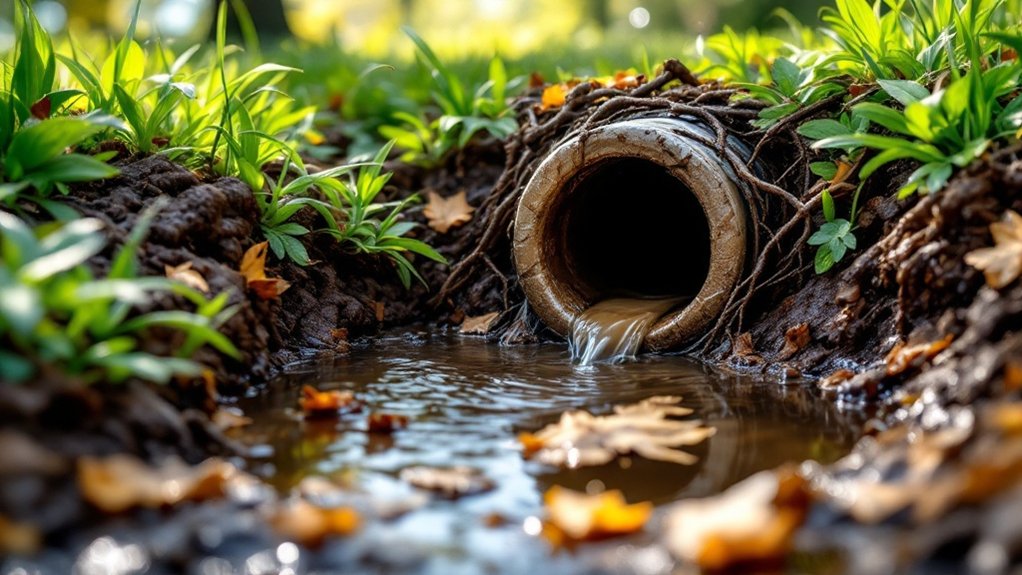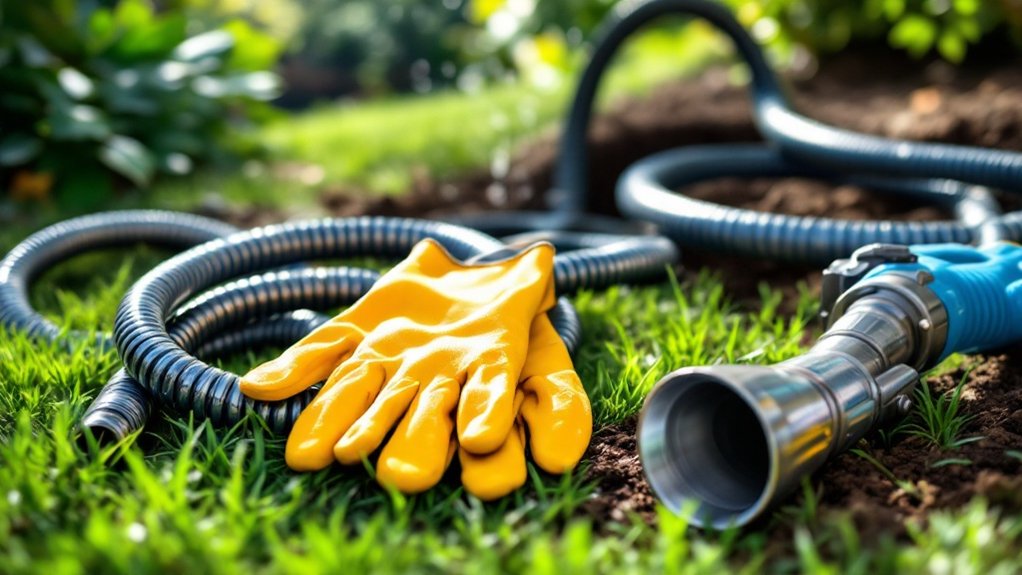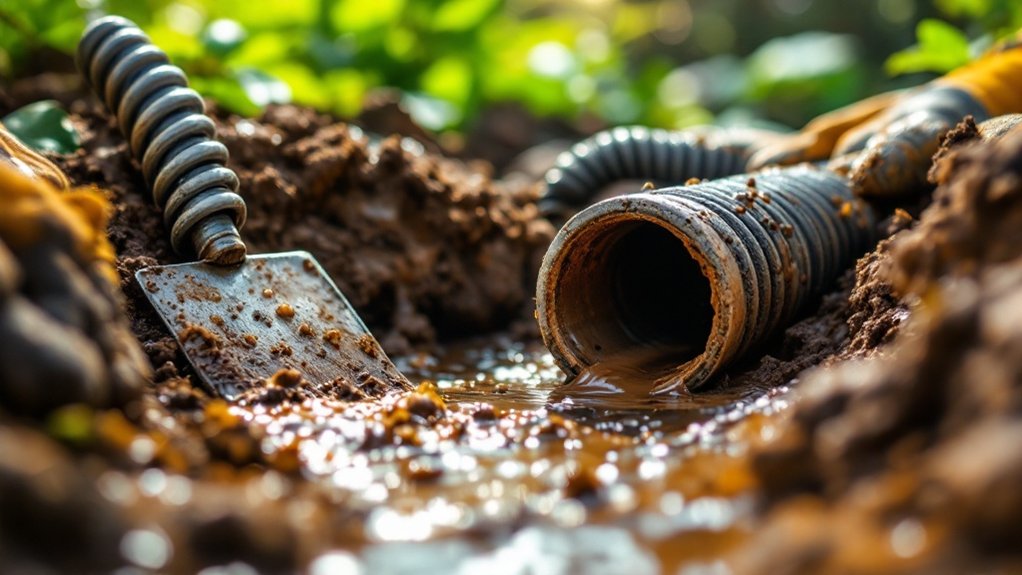To unclog underground outdoor drainage pipes, start with water jetting by inserting the nozzle 1-2 feet into the pipe. For stubborn blockages, use a drain snake or auger to physically break apart obstructions. Alternatively, try a blow bag with compressed air to force clogs through. Always wear proper safety gear during these operations. If water continues pooling or drains remain slow after multiple attempts, underlying issues may require professional plumbing intervention.
Key Takeaways
- Use a high-pressure water jetter to forcefully flush out debris by inserting the tip 1-2 feet into the pipe.
- Deploy a drain snake or auger to physically break up stubborn blockages in underground pipes.
- Apply a blow bag with compressed air to force water through the pipe and dislodge obstructions.
- Clear catch basins and entry points of visible debris before addressing the underground portion.
- Call a professional if blockages persist, as they have specialized equipment for deep underground clogs.
Signs Your Underground Drainage Pipe Is Clogged

How can you tell when that hidden drainage pipe in your yard has a problem? Look for water pooling around foundations, downspouts, or drains—the most obvious indicator of a blockage.
During rainy periods, visible puddles will form, while dry spells may reveal water stains and damp soil.
Watch for leaks at downspout adapters or water gushing back from drainage pipes. Foul odors and sewage backup in fixtures like bathtubs signal serious clogs.
Multiple slow-draining fixtures accompanied by gurgling sounds indicate a main line blockage. Foundation cracks and unusually lush vegetation patches can reveal longstanding drainage issues. Additionally, consider consulting a drainage specialist to assess and address any potential problems effectively.
Essential Tools for Unclogging Outdoor Drains

Unclogging outdoor drainage pipes requires specialized equipment designed for external plumbing systems.
You’ll need high-pressure jetting equipment for forceful debris removal, manual clearing tools like augers or drain snakes for physical obstruction management, and inspection devices such as borescope cameras to identify blockage locations.
These essential tools will help you effectively diagnose and resolve outdoor drainage issues without causing damage to your underground pipe network.
High-Pressure Jetting Equipment
Powerful water force serves as the cornerstone of high-pressure jetting equipment, essential for tackling stubborn blockages in outdoor drainage pipes. Operating at up to 1500 psi, these machines efficiently clear roots, grease, and debris that conventional methods can’t address.
Select the appropriate nozzle for your specific blockage—cutting nozzles for roots, penetrating types for grease. The high pressure benefits include thorough pipe wall cleaning without chemicals, making this method environmentally friendly and cost-effective long-term.
For outdoor applications, consider gas-powered jetters for mobility, but always wear proper safety gear and guarantee you’ve received adequate training before operation.
Manual Clearing Tools
Manual clearing tools represent the first line of defense against outdoor drain blockages, offering accessible solutions without the power requirements of jetting equipment.
Drain snakes provide the most effective approach, with models extending up to 50 feet for deep pipe access. For surface-level clogs, manual augers in 1/2″ or 3/4″ sizes can break apart debris through rotation.
Plunger techniques work primarily on accessible, short drain runs by creating hydraulic pressure. For hair and small material, consider drain sticks with barbs.
Bladder openers provide moderate pressure for soft clogs without chemicals, though they’re ineffective against root intrusions.
Inspection Devices
When faced with stubborn outdoor drainage clogs, inspection devices serve as your diagnostic eyes beneath the surface. Modern inspection technology offers precise identification of blockage locations before you start digging or snaking blindly.
Essential camera inspection tools include:
- Waterproof pipe cameras with HD imaging for detailed clog visualization
- Self-leveling camera heads that maintain orientation regardless of pipe angles
- LED-integrated systems that illuminate dark underground networks
- Digital zoom capabilities (up to 4X) for examining specific problem areas
- Wireless monitors or app-based systems for recording and sharing findings
Using these advanced camera features notably reduces guesswork, verifies cleaning success, and helps map unknown utility configurations without unnecessary excavation.
Step-by-Step Pipe Unclogging Methods

Unclogging an outdoor drainage pipe requires systematic application of proven methods that address different types of blockages.
Begin with water jetting, inserting the jetter tip 1-2 feet into the pipe and using high-pressure water with a tugging motion to break up clogs. For stubborn blockages, employ cable rodding to physically break apart obstructions while maintaining proper pipe maintenance.
Alternative methods include using a blow bag with compressed air to force clogs through the pipe, or manual plunging for accessible openings.
Always follow unclogging with thorough flushing to guarantee complete debris removal and proper flow, enhancing clog prevention.
Preventative Maintenance Strategies
Preventing outdoor drainage clogs is far more efficient than addressing them after they’ve formed. Implementing preventive measures greatly extends your system’s lifespan and reduces costly emergency repairs. Routine inspections form the foundation of effective drainage maintenance.
Proactive drainage maintenance saves time, money, and prevents system failures before they begin.
- Install strainers on all drainage entry points to block debris
- Clean catch basins and surface grates quarterly
- Maintain proper landscape grading to prevent sediment entry
- Apply enzymatic cleaners biannually to dissolve organic buildup
- Schedule professional inspections with camera equipment annually
Remember to monitor for standing water near outlets—this indicates potential blockages requiring immediate attention.
Keep surrounding vegetation trimmed to prevent root intrusion into your underground pipe system.
When to Call a Professional Plumber
While most minor drainage clogs can be resolved with DIY methods, recognizing the threshold for professional intervention is essential for preventing costly damage.
Call a professional immediately when you encounter persistent slow drainage despite multiple clearing attempts, recurring blockages, foul odors from drains, or gurgling sounds in the system.
Plumbing emergencies like underground pipe bursts require immediate expert attention.
Professional drainage solutions include specialized equipment like video camera inspections and hydro-jetting that effectively address stubborn underground clogs.
Remember that DIY attempts beyond your capability can worsen blockages, potentially leading to foundation damage and costly repairs.
Common Causes of Underground Pipe Blockages
Underground drainage pipe blockages stem from several predictable culprits that compromise your system’s functionality over time.
Understanding these causes helps you prevent costly repairs and maintain proper water flow.
- Grease buildup from kitchen waste solidifies in cold pipes, gradually reducing diameter
- Tree root intrusion seeking moisture, especially in older or cracked piping systems
- Non-biodegradable items incorrectly flushed into the system, including “flushable” wipes
- Limescale and mineral deposits accumulating in areas with hard water
- Soil shifts and ground movements causing pipe misalignment or structural damage
Regular inspection and maintenance targeting these specific issues will greatly extend your drainage system’s lifespan.




